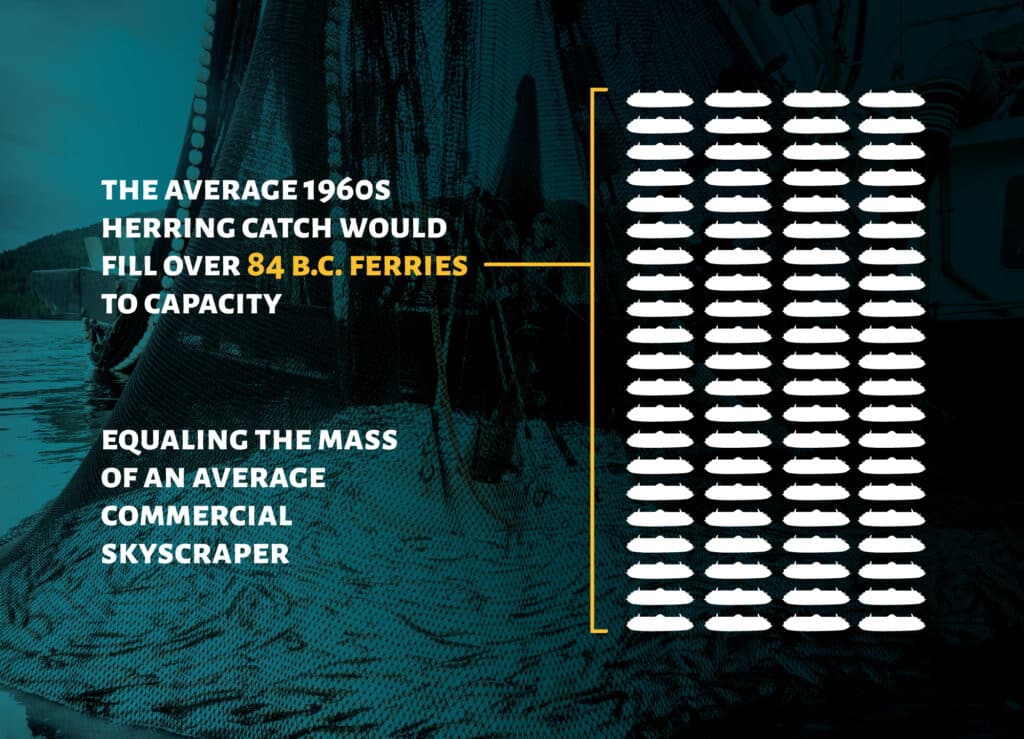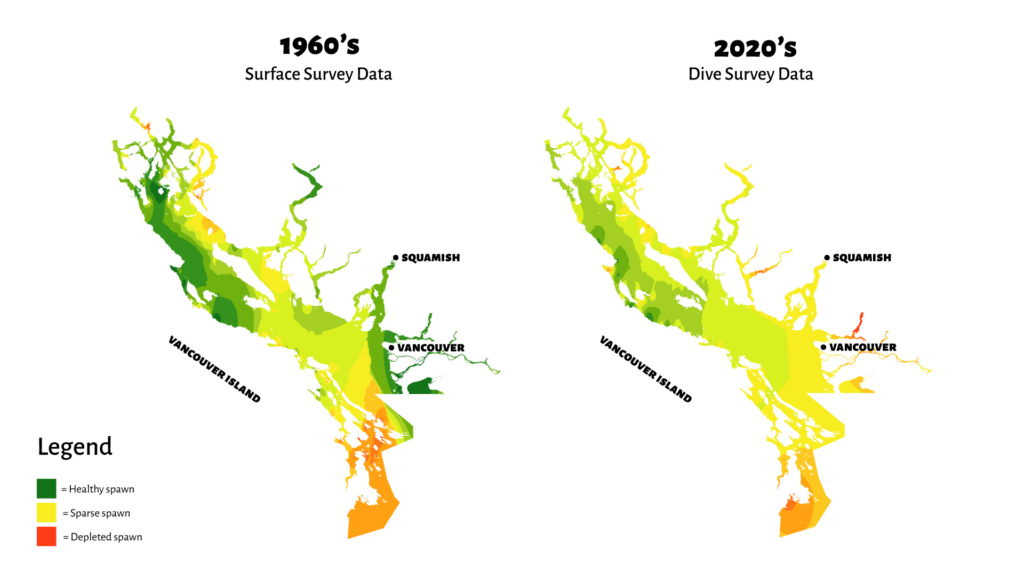introduction
A concerning ecological trend is unfolding in the once-thriving Pacific herring populations across British Columbia (B.C.). Both the geographical range and duration of herring spawning events are declining with spawning events typically starting later and completing earlier than in the historic record. While 2024 excitingly featured spawning activity in areas where it had been absent for a long while, many coves and inlets along the coast of B.C. that used to consistently see local herring spawn year after year, have been silent for decades. Temporally, the herring spawn historically spanned from January to May in Coast Salish territories. In contrast, today’s spawning activity is largely restricted to late February and March in the Strait of Georgia (SoG) with some exceptions. This range has been diminishing for many years.
The Pacific herring fishery started in British Columbia in the 19th century. Herring became the major pelagics fishery in B.C. after the collapse of the Pacific sardine in the late 1940s due to overfishing and unfavourable environmental conditions for sardine recovery. Over their long history of exploitation, B.C.’s five major herring stocks experienced similar depletions in the 1930s and 1960s followed by rapid recoveries in some areas after temporary moratoriums were instated. However, in the last two decades, the abundance of spawn, as well as size of herring returning to spawn have declined to various degrees.
Biomass of herring spawn estimated by surface and dive surveys from 1960-2023.
Source: DFO
Explore this data in an interactive map below
key timeline insights
The commercial reduction fishery collapsed in 1967. After a short moratorium, the modern day roe fishery began in 1972. By 2003, Haida Gwaii’s herring stock had been depleted and was closed to commercial gillnet and seine fishing for roe. Shortly after, in 2006, the west coast of Vancouver Island was closed for commercial herring fisheries. In 2008, the gillnet and seine roe fishery on the central coast was closed as well. Against the advice of fisheries scientists, 13 seine licenses were allocated in 2014 in Haida Gwaii but were not fished. In 2015, the Council of the Haida Nation successfully filed an injunction against DFO to keep the fishery closed. In 2015, following intense discussions, demonstrations, and a three-day Heiltsuk occupation of the DFO office near Bella Bella the gillnet and seine fishery remained closed after DFO initially moved to open the roe fishery against the advice of their own scientists. First Nations play a fundamental role in herring conservation and recovery by advocating for fisheries to remain closed within their territories.
As spawning grounds vanish, the rich tapestry of biodiversity woven together by the presence of herring may begin to unravel. Species that depend on the annual return and spawn of Pacific herring such as Chinook and coho salmon, hake, halibut, and recently recovering humpback whales will likely suffer in the absence of their preferred prey. Additionally many communities have had to halt their traditional local harvesting due to a lack of fish.
Slhewut (2022) is a short film about the Hul’q’umi’num knowledge of herring. The film project was a collaboration between Trailmark Systems, the Q’ul-lhanumutsun Aquatic Resources Society, participants from Cowichan Tribes, Penelakut Tribe, and Stz’uminus First Nation, and Kingtide Films Ltd.
Herring, A History of exploitation
Despite their importance, Pacific herring has been commercially exploited in B.C. since the late 19th century. Herring populations throughout B.C. have declined precipitously over more than 100 years. The factors that affect herring populations are complex: water temperature, food availability, predator and competitor populations all play a role in herring biomass at any given time and fluctuations in population number is widely accepted as normal by the scientific community. However, the devastating loss of herring abundance, diversity and range in B.C. is clearly attributed to the onset of early commercial fisheries operating rampant with very little initial oversight or regulation.
The reduction fishery began to harvest herring en masse in the late 1800s and by the late nineteenth century the preferred method for fishing herring was with dynamite. In the early reduction fishery, herring were caught and rendered into oil used for lubricating skid rows in forestry and by the 1960s the herring harvest in B.C. was still not utilized directly for human consumption but rather as a protein and mineral-rich supplement in the diet of poultry, pigs and mink raised in agriculture and industrial fur farms. The edible fish oil was then shipped by rail and truck to markets in Canada and the United States for use in the manufacture of soaps, paints, and cooking compounds.
In the 1962-63 fishing season, the B.C. herring catch peaked at around 237,600 metric tonnes. More herring was harvested that year than the entire spawning biomass that remains in B.C. today, estimated to be around 191,537 tonnes in 2024. In the 1960s, following decades of extremely high catches, herring populations crashed coastwide from overfishing. Today, the majority of herring populations in B.C. have declined to historic low levels. The Strait of Georgia (SoG) remains the last stronghold for spawning Pacific herring in the province. In 2024, the median return estimates indicate that over 42% of B.C.’s spawning biomass of herring can be found in the SoG alone.

Today, though the use of dynamite, pit lamps, and unregulated harvest is prohibited, the modern- day management system for herring is based on a shockingly incomplete picture of historic herring populations in B.C.. Fisheries and Oceans Canada (DFO) compares current population estimates to data from 1951, even though herring populations were already severely depressed by large-scale, industrial fishing for nearly 50 years prior (herring harvest began in small quantities around 1888 and catch levels increased rapidly in the following years). Therefore, industrial fishing of Pacific herring had been occurring for half a century before scientific description of local ecosystems had begun.
By 1910, government officials noted that herring were less common in areas where they had once been abundant and recent research estimates that forage fish populations may have already decreased by as much as 99% since European contact in some areas. Using data from 1951 as a population baseline is egregiously misleading and is an iconic example of shifting baseline syndrome. It conceals the declines caused by the early fishery and limits the scope of recovery for B.C. herring populations.
Case Study: mapping spawning sites in The Strait of Georgia
Using the Strait of Georgia (SoG) as a case study, decades of data reveal a disquieting pattern. From south-to-north, herring spawning grounds are diminishing, and the signs of this decline are unmistakable. Spawning grounds in Areas 19 and 18 have largely succumbed to silence following sudden, severe, and persistent collapses in the 1950s and 1980s, respectively. In recent years, Area 17 has seen a sharp decline in spawning events, reaching their lowest levels on record.

Over two decades ago, a DFO report hypothesised that the spatiotemporal loss of spawn spreading across B.C. may be attributed to pressures from commercial fisheries, climate change, or that this change may simply be perceived as a loss because of a decrease in data collection. Once the landed quantity and value of commercial herring fisheries began to fade rapidly in B.C. during the 1990s, this was accompanied by an apparent divestment into the effort going into monitoring herring by DFO.
Despite the urgency of the situation, Fisheries and Oceans Canada (DFO) has yet to address the crisis of spawn loss in a meaningful way. The drivers of this decline remain unidentified and without this crucial understanding, efforts to manage SoG herring fisheries are akin to navigating blindfolded.
For decades, DFO has been managing herring in the SoG as one homogenous unit rather than separating them into distinct resident (local) and migratory populations despite years of evidence dating back to the 1930s that the difference exists. When small local stocks are fished as part of a larger-scale quota, they are at risk of collapsing. In the SoG, many of these small local stocks were likely extirpated after the massive stock collapse in the 1960s.
Mapping the disappearance of local herring spawn sites over time. Video courtesy of the Conservancy Hornby Island. Thank you to Briony Penn and video creator, Alex Harris.
Today, the geographical areas where spawning still takes place have been growing increasingly smaller, with a few notable exceptions. Even the pockets within the Strait of Georgia that have seen consistently high spawning activity, are at risk of shrinking and growing fewer and farther between. This decline underscores the urgent need for targeted conservation efforts to mitigate the repercussions on the marine ecosystem.
Explore the map below to see spawning biomass change over time across coastal British Columbia.
Data for this map was sourced from DFO. Between 1960 and 1989 this data represents miles of spawn recorded using surface methodology, largely by airplane flight surveys. Between 1989 and 2020 this data represents miles and quantity of spawn recorded by dive surveys.
As spawning grounds shrink and spawning periods shorten, the behavioral and genetic diversity essential to the resilience of the herring population diminishes. As diversity dwindles, and the heterogeneous array of spawning grounds diminishes, the ecosystem is left more vulnerable to the effects of disturbance. We are witnessing not just the decline of a species but the erosion of an ecosystem’s resilience in the face of mounting threats, like climate change.
looking forward in uncertain times
Climate change casts a long shadow over B.C.’s marine environment, with record-breaking heatwaves and shifting oceanic conditions posing existential threats to herring populations already under strain. In the Strait of Georgia, climate projections indicate higher air and water temperatures are on the horizon.
On the east coast of Canada, herring populations are failing to recover despite a moratorium on fishing activity for two years. DFO biologists report that the conditions that allow the fish to be able to rebuild are not there, and they do not expect this to change in the near future. In the Pacific Northwest, herring stocks in other jurisdictions, like California, have experienced collapses that have been attributed to El Nino conditions, which are characterized by warm, above-average sea-surface temperatures. B.C. is currently in one of the strongest El Nino events ever recorded in the region.
As sea surface temperatures rise, juvenile herring in early life stages are likely to be profoundly affected as temperature affects metabolism and growth. As a single stressor, elevated temperature has been shown to generate greater embryo heart rates and mortality, lower hatching success, and shorter larval lengths. Increased temperatures can also result in the development of abnormalities in the pectoral fins and spinal cords. These abnormalities likely affect survival as diminished swimming performance can lead to decreased success in capturing prey and a higher likelihood that herring will be captured as prey themselves.
As we navigate the uncertain waters ahead, let us heed the lessons of history and embrace the opportunity to foster a future where herring thrive once more, enriching our coastal communities and ecosystems for generations to come. The adoption of a precautionary approach is paramount to mitigating the risk of our last remaining healthy herring stocks slipping into a low-productivity, low biomass state as seen in other places of the province.
In B.C., history tells us that temporary moratoriums on commercial fishing can work to help herring populations recover if environmental conditions remain favourable. Following the stock collapse in the 1960s, the commercial reduction fishery was closed in 1967. After a few short years, following the advantageous combination of favourable environmental conditions and a low harvest rate, DFO deemed the stock “recovered” (at least, recovered enough by 1951 population baseline standards to support further commercial extraction) by the mid-1970s and the modern roe fishery began in 1972. Herring are a resilient fish and, if given the chance, it is likely that they can recover again today in a robust and meaningful way while climate conditions still allow them to do so.
Temporary fisheries closures are an actionable item DFO can take to mitigate uncertainty as well as known threats to the continued survival of Pacific herring. Taking this action now will help protect the long-term survival not only of the ecosystem but the fishery as well.
Join us in pressuring Fisheries and Oceans Canada to mandate a managed pause on the commercial gillnet and seine roe fisheries in the 2025 fishing season in order to take proactive measures guided by the precautionary principle.
#ProtectPacificHerring

